One of the oldest of the Microsoft Office applications – Excel is already packed with a rich set of features. As a developer many times we have to work with excel files like creating/modifying etc. Programming with Excel can be a crucial solution with data-rich projects/applications.
ByteScout Spreadsheet SDK provides many features that let the developer create rich Microsoft Excel solutions with the use of its easy and extensive SDKs.
In this article, we are going to explore the various features of ByteScout Spreadsheet SDK which helps you to unlock its full potential by covering some test cases code written in C#.
Note: Before we start, please download and install ByteScout Suites and SDK in your machine.
In the following articles, we are going to walk through some programs demonstrating basic Excel programming with ByteScout Spreadsheet SDK and learn how to:
Let’s write this step-by-step.
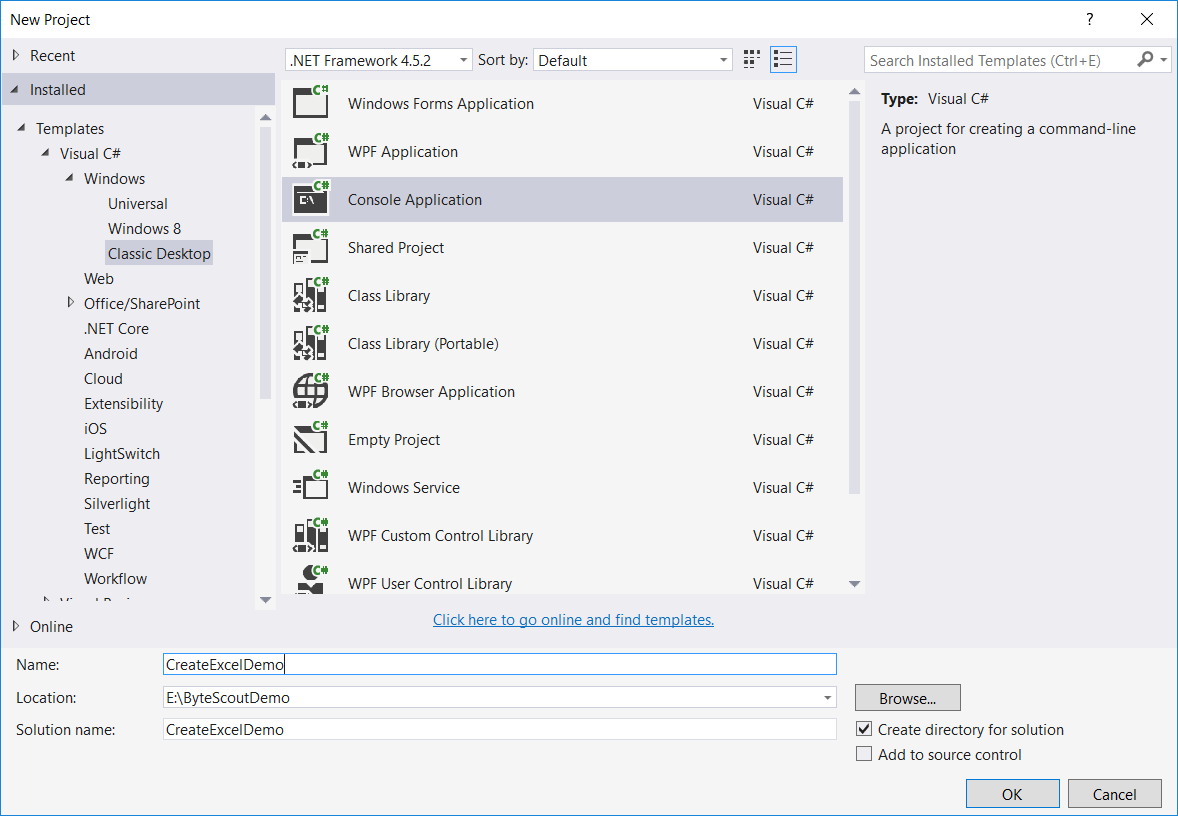

using System.Diagnostics;
using System. Drawing;
using Bytescout.Spreadsheet;
using System.IO;
class Program
{
static void Main(string[] args)
{
// Create new Spreadsheet
Spreadsheet document = new Spreadsheet();
//add new worksheet
Worksheet worksheet = document.Workbook.Worksheets.Add(); // <-- Add worksheet with default name - "Untitled-1"
// Using below code you can give custom name to your worksheet
//Worksheet worksheet = document.Workbook.Worksheets.Add("ByteScoutSheet");
// Write the sample text
worksheet.Cell("A1").Value = "Demo Excel created using ByteScout Spreadsheet SDK";
worksheet.Cell("A1").Font = new Font("Verdana", 18, FontStyle.Bold);
worksheet.Cell("A1").FontColor = Color.BlueViolet;
if (File.Exists("MyNewExcelFile.xls"))
File.Delete("MyNewExcelFile.xls");
// Save document
document.SaveAs("MyNewExcelFile.xls");
// Close Spreadsheet
document.Close();
// open generated XLS document in default program
Process.Start("MyNewExcelFile.xls");
}
}
And here’s the output.
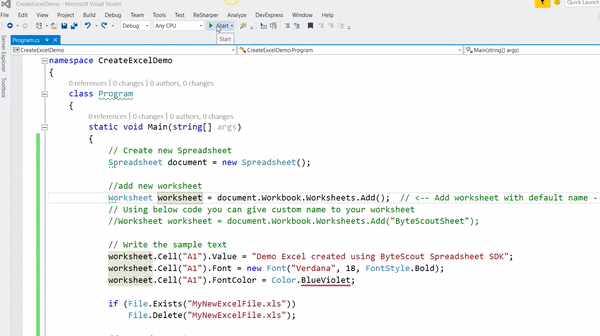
Let’s understand the above code step by step.
// Create new Spreadsheet
Spreadsheet document = new Spreadsheet();
// add new worksheet
Worksheet Sheet = document.Workbook.Worksheets.Add("ByteScoutSheet");
You can create a worksheet without specifying any name using the following code.
//add new worksheet
Worksheet worksheet = document.Workbook.Worksheets.Add();
Well, the above code will add the worksheet with the default name -“Untitled-1”.
// Write the sample text
worksheet.Cell("A1").Value = "Demo Excel created using ByteScout Spreadsheet SDK";
worksheet.Cell("A1").Font = new Font("Verdana", 18, FontStyle.Bold);
worksheet.Cell("A1").FontColor = Color.BlueViolet;
// delete MyNewExcelFile file if exists already
if (File.Exists("MyNewExcelFile.xls")){
File.Delete("MyNewExcelFile.xls");
}
// Save document
document.SaveAs("MyNewExcelFile.xls");
In this program, we will create multiple sheets with two different approaches.
It is shown in the first demo program.
using System.Diagnostics;
using System.Drawing;
using System.IO;
using Bytescout.Spreadsheet;
class Program
{
static void Main(string[] args)
{
// Create new Spreadsheet
Spreadsheet document = new Spreadsheet();
//add multiple worksheet
Worksheet worksheet1 = document.Workbook.Worksheets.Add("MyNewWorksheet 1");
Worksheet worksheet2 = document.Workbook.Worksheets.Add("MyNewWorksheet 2");
// Write the sample text in worksheet1
worksheet1.Cell("A1").Value = "Hello World in - MyNewWorksheet 1";
// Set the font
worksheet1.Cell("A1").Font = new Font("Verdana", 14, FontStyle.Bold);
// Set the color
worksheet1.Cell("A1").FontColor = Color.BlueViolet;
// Write the sample text in worksheet2
worksheet2.Cell("A1").Value = "Hello World in - MyNewWorksheet 2";
worksheet2.Cell("A1").Font = new Font("Verdana", 14, FontStyle.Bold);
worksheet2.Cell("A1").FontColor = Color.Coral;
if (File.Exists("MultipleWorksheetDemo.xls"))
File.Delete("MultipleWorksheetDemo.xls");
// Save document
document.SaveAs("MultipleWorksheetDemo.xls");
// Close Spreadsheet
document.Close();
// open generated XLS document in default program
Process.Start("MultipleWorksheetDemo.xls");
}
}
As we can see in the above code snippet which itself is self-explanatory where we add multiple worksheets using the following code and then write the text in each worksheet.
//add multiple worksheet
Worksheet worksheet1 = document.Workbook.Worksheets.Add("MyNewWorksheet 1");
Worksheet worksheet2 = document.Workbook.Worksheets.Add("MyNewWorksheet 2");
In this approach, we are using one of the cool features of C# which is – Extension method For that we need to create one static class which contain our extension method like this:
public static class ExtensionUtil
{
public static void CreateWorkSheets(this Spreadsheet document, params string[] workSheetNames)
{
foreach (var workSheetName in workSheetNames)
{
document.Workbook.Worksheets.Add(workSheetName);
}
}
}
And here is the full code of how to use it in our main method.
class Program
{
static void Main(string[] args)
{
// Create new Spreadsheet
Spreadsheet document = new Spreadsheet();
//add multiple worksheet
document.CreateWorkSheets("MyNewWorksheet 3", "MyNewWorksheet 4", "MyNewWorksheet 5");
// Get worksheet object by its name
Worksheet worksheetObj = document.Workbook.Worksheets.ByName("MyNewWorksheet 3");
// ----- OR you can use below code to get the worksheet object by its name in indexer
//Worksheet worksheetObj = document.Workbook.Worksheets["MyNewWorksheet 3"];
// ------ OR you can use below code to get the worksheet object by its index position in indexer
//Worksheet worksheetObj = document.Workbook.Worksheets[2];
// Write the sample text in worksheetObj
worksheetObj.Cell("A1").Value = "Hello World in - MyNewWorksheet 3";
// Set the font
worksheetObj.Cell("A1").Font = new Font("Verdana", 14, FontStyle.Bold);
worksheetObj.Cell("A1").FontColor = Color.DarkCyan;
if (File.Exists("MultipleWorksheetDemo.xls"))
File.Delete("MultipleWorksheetDemo.xls");
// Save document
document.SaveAs("MultipleWorksheetDemo.xls");
// Close Spreadsheet
document.Close();
// open generated XLS document in default program
Process.Start("MultipleWorksheetDemo.xls");
}
}
public static class ExtensionUtil
{
public static void CreateWorkSheets(this Spreadsheet document, params string[] workSheetNames)
{
foreach (var workSheetName in workSheetNames)
{
document.Workbook.Worksheets.Add(workSheetName);
}
}
}
//add multiple worksheet
document.CreateWorkSheets("MyNewWorksheet 3", "MyNewWorksheet 4", "MyNewWorksheet 5");
* Approach 1 – Using “ByName()” method of worksheets object
// Get worksheet object by its name
Worksheet worksheetObj = document.Workbook.Worksheets.ByName("MyNewWorksheet 3");
* Approach 2 – Using indexer of worksheets object by specifying worksheet name
// Get worksheet object by its name
Worksheet worksheetObj = document.Workbook.Worksheets["MyNewWorksheet 3"];
* Approach 3 – Using indexer of worksheets object by specifying the index position
// Get worksheet object by its index position
Worksheet worksheetObj = document.Workbook.Worksheets[2];
And then we write some sample text in the worksheet and generate our required file.
Here’s the output.
This is a very interesting feature of the ByteScout Spreadsheet library. Consider a scenario where you want to share an excel file with other developers or an organization and which contains some important formula and you don’t want that other user can see or edit your formula. Well, ByteScout Spreadsheet SDK has already one method using which we can easily achieve this type of requirement.
Let’s implement it step-by-step.
using System.Diagnostics;
using System.IO;
using Bytescout.Spreadsheet;
class Program
{
static void Main(string[] args)
{
// Create new Spreadsheet
Spreadsheet document = new Spreadsheet();
//add new worksheet
Worksheet worksheet = document.Workbook.Worksheets.Add("ProtectedWorksheetDemo");
// Write the sample text in worksheet1
worksheet.Cell(0, 0).Value = "Can't edit this worksheet as it contain some confidential formula.";
worksheet.Cell(2, 0).Value = "Right click on sheet name => Unprotect Sheet => Enter password";
worksheet.Columns[0].Width = 150;
worksheet.Cell(5, 0).Value = "Total Revenue";
worksheet.Cell(5, 1).HiddenFormula = true;
worksheet.Cell(5, 1).Value = "=(3.14*20000)";
// Set the worksheet with password
worksheet.Protect("byteScout@123");
if (File.Exists("ProtectedWorksheetDemo.xls"))
File.Delete("ProtectedWorksheetDemo.xls");
// Save document
document.SaveAs("ProtectedWorksheetDemo.xls");
// Close Spreadsheet
document.Close();
// open generated XLS document in default program
Process.Start("ProtectedWorksheetDemo.xls");
}
}
Here’s the output.
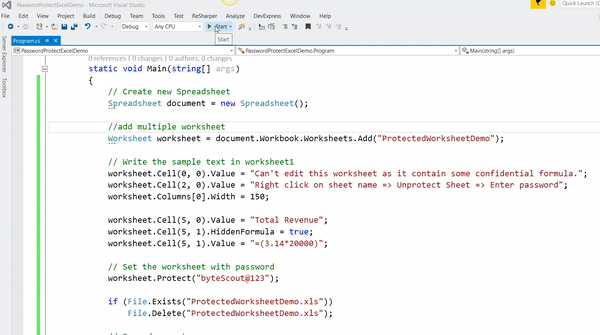
Let’s understand the above code step by step.
// Write the sample text in the worksheet
worksheet.Cell(0, 0).Value = "Can't edit this worksheet as it contains some confidential formula.";
worksheet.Cell(2, 0).Value = "Right click on sheet name at bottom left => Choose "Unprotect Sheet" => Enter password";
worksheet.Columns[0].Width = 150;
worksheet.Cell(5, 0).Value = "Total Revenue";
worksheet.Cell(5, 1).HiddenFormula = true;
worksheet.Cell(5, 1).Value = "=(3.14*20000)"; // <– This is a secret formula
// Set the worksheet with password
worksheet.Protect("byteScout@123");
Now when you run this application, it will open the worksheet protected Excel file. If you try to edit any cell then it will open the following dialog.

So now to unprotect it what you need to do is – Right-click on sheet name at the bottom left => Choose “Unprotect Sheet” which will ask you to enter the password as shown below.
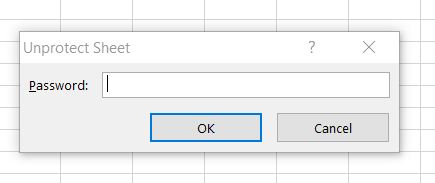
Once you entered the correct password, you can edit the file and can also see our secret formula in the formula bar of excel.
In this step, we will create an excel file by adding some formulas which are supported by ByteScout Spreadsheet library.
using System.Diagnostics;
using System.IO;
using Bytescout.Spreadsheet;
class Program
{
static void Main(string[] args)
{
// Create new Spreadsheet
Spreadsheet document = new Spreadsheet();
//add new worksheet
Worksheet worksheet = document.Workbook.Worksheets.Add("FormulasheetDemo");
// Get list separator. List separator depends from locale.
string listSeparator = document.Workbook.Locale.TextInfo.ListSeparator;
// Write the sample text in worksheet1
worksheet.Cell(0, 0).Value = "Excel Formula Demo.";
worksheet.Columns[0].Width = 100;
int rowNumber = 2;
// Example on SQRT() function in formula
worksheet.Cell(rowNumber, 0).Value = "SQRT(9)";
worksheet.Cell(rowNumber, 1).Value = "=SQRT(9)";
rowNumber += 2;
// Example on PI() function in formula
worksheet.Cell(rowNumber, 0).Value = "PI()";
worksheet.Cell(rowNumber, 1).Value = "=PI()";
rowNumber += 2;
// Example on LEN() function in formula
worksheet.Cell(rowNumber, 0).Value = "LEN(\"Bytescout\")";
worksheet.Cell(rowNumber, 1).Value = "=LEN(\"Bytescout\")";
rowNumber += 2;
// Example on YEAR() function in formula
worksheet.Cell(rowNumber, 0).Value = "YEAR(NOW())";
worksheet.Cell(rowNumber, 1).Value = "=YEAR(NOW())";
rowNumber += 2;
// Example on SUM() function in formula
worksheet.Cell(rowNumber, 0).Value = "SUM(5" + listSeparator + "3)";
worksheet.Cell(rowNumber, 1).Value = "=SUM(5" + listSeparator + "3)";
rowNumber += 2;
// Example on COUNTA() function in formula
worksheet.Cell(rowNumber, 0).Value = "COUNTA(B1:B11)";
worksheet.Cell(rowNumber, 1).Value = "=COUNTA(B1:B11)";
if (File.Exists("ExcelFormulaDemo.xls"))
File.Delete("ExcelFormulaDemo.xls");
// Save document
document.SaveAs("ExcelFormulaDemo.xls");
// Close Spreadsheet
document.Close();
// open generated XLS document in default program
Process.Start("ExcelFormulaDemo.xls");
}
}
Bytescout.Spreadsheet support almost every mathematical function like here we have “=SQRT(9)”, “=COS(30)”, “=LOG10(5)” etc. “LEN()” function in a formula will return the length of the passing parameter. We can have data manipulation related functions like – “=YEAR(NOW())”, “MONTH(NOW())”, “=WEEKDAY(NOW()) etc. We can also have aggregate function like – “=COUNT(B1:B10)”, “=MAX(50,30)”, “=MIN(50, 30)” etc. This list goes on and on. The best way to know the code is to debug it and make a small change in the above code to see what happens.
Here’s the output.
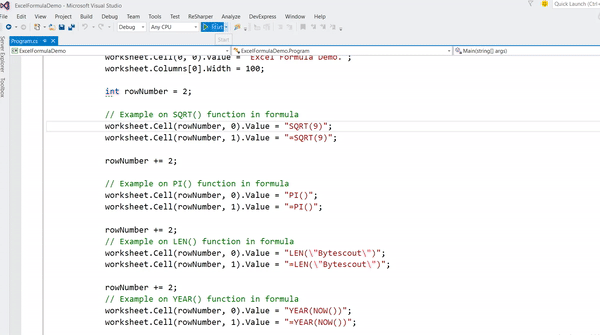
In this article, we have explored the four different features to manipulate the excel and the features list is not limited. ByteScout Spreadsheet SDK has many more features and we will explore some more advanced features in the next article. Till then stay tuned and stay updated with us.
Happy Coding 🙂